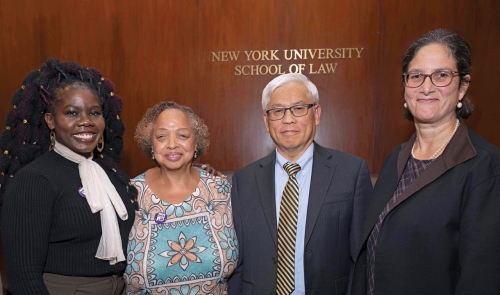Environmental Justice Initiative launches with movement pioneers

Expert panelists Abre’ Conner, Vernice Miller-Travis, and Charles Lee, and moderator Marianne Engelman-Lado
NYU Law’s new Environmental Justice Initiative, a joint research and advocacy effort of the Center on Race, Inequality, and the Law and the Guarini Center on Environmental, Energy, and Land Use Law, celebrated its launch with an inaugural event on October 15. Following opening remarks by Dean Troy McKenzie ’00, an expert panel discussed the past, present, and future of environmental and climate justice.
“Across this country, around the world, we see that low-income communities and communities of color bear disproportionate burdens of environmental harm, whether polluted air and water, or the devastating effects of climate change,” said McKenzie. “Addressing all of these inequities requires a range of approaches and a broad toolkit.”
“The goal is to have this initiative serve as a hub for research, for teaching, for advocacy, all aimed at ensuring that every person—regardless of their background, race, income, ZIP code—has access to clean air, clean water, and a safe and healthy place to live and raise a family,” the dean said. “And I think all of that is deeply ingrained in our mission at NYU Law to use the law…as a force for good, for equity, for accountability, and for opportunity.” McKenzie also thanked attorneys Marie Napoli LLM ’01 and Paul Napoli, whose gift provided for the establishment of the EJ Initiative.
Following McKenzie’s introduction, Marianne Engelman-Lado, the director of the EJ Initiative and former deputy general counsel for environmental initiatives in the Office of General Counsel during the Biden administration, moderated a panel of environmental justice experts. The panelists included Charles Lee, visiting scholar at Howard University School of Law, who worked at the US Environmental Protection Agency for more than two decades, and Vernice Miller-Travis, executive vice president at Metropolitan Group, both considered founders of the environmental justice movement, as well as Abre’ Conner, director of environmental and climate justice at the NAACP. They discussed the origins and key principles of the environmental justice movement, the challenges of its current landscape, their vision for the movement’s future, and battles both frustrating and uplifting.
Selected remarks from the discussion:
Vernice Miller-Travis: “People live where they live…not because they chose to live there, but because they were forced to live there. And many of those places were ecologically vulnerable from the beginning…. The places that were vulnerable to begin with, of course, are going to be even more vulnerable from the threats of climate change…. So the vulnerability is not accidental. It’s just like what we found in toxic waste and race. It is by design. And if you want to unpack that, if you want to make communities safer, you’ve got to go back to the source. And the source is residential segregation.”
Abre’ Conner: “What the future of this work needs to look like is having folks who are doing work in policy, advocacy, mobilization, research in academia, or traditional organizers and activists…. Communications, for sure, has been a major factor in how we’ve been able to shift the narrative…by highlighting this in the media and shaming a lot of these tech companies for what they’re doing, but [we need] to have all of those components working together in an intersectional way to amplify that we’re going to put up a united front.”
Charles Lee: “The example of Spartanburg, South Carolina, and the ReGenesis environmental justice partnership is a great one to lift up. This is a small area…that was host to two Superfund sites, six brownfield sites, and [they] decided that they wanted to…not just look at the issues in front of them, but to envision what the community would look like, and [they] came up with a plan for wholesale community revitalization. So they started with an EPA environmental justice small grant of $20,000 and leveraged it into over $300 million of public-private partnership resources.”


